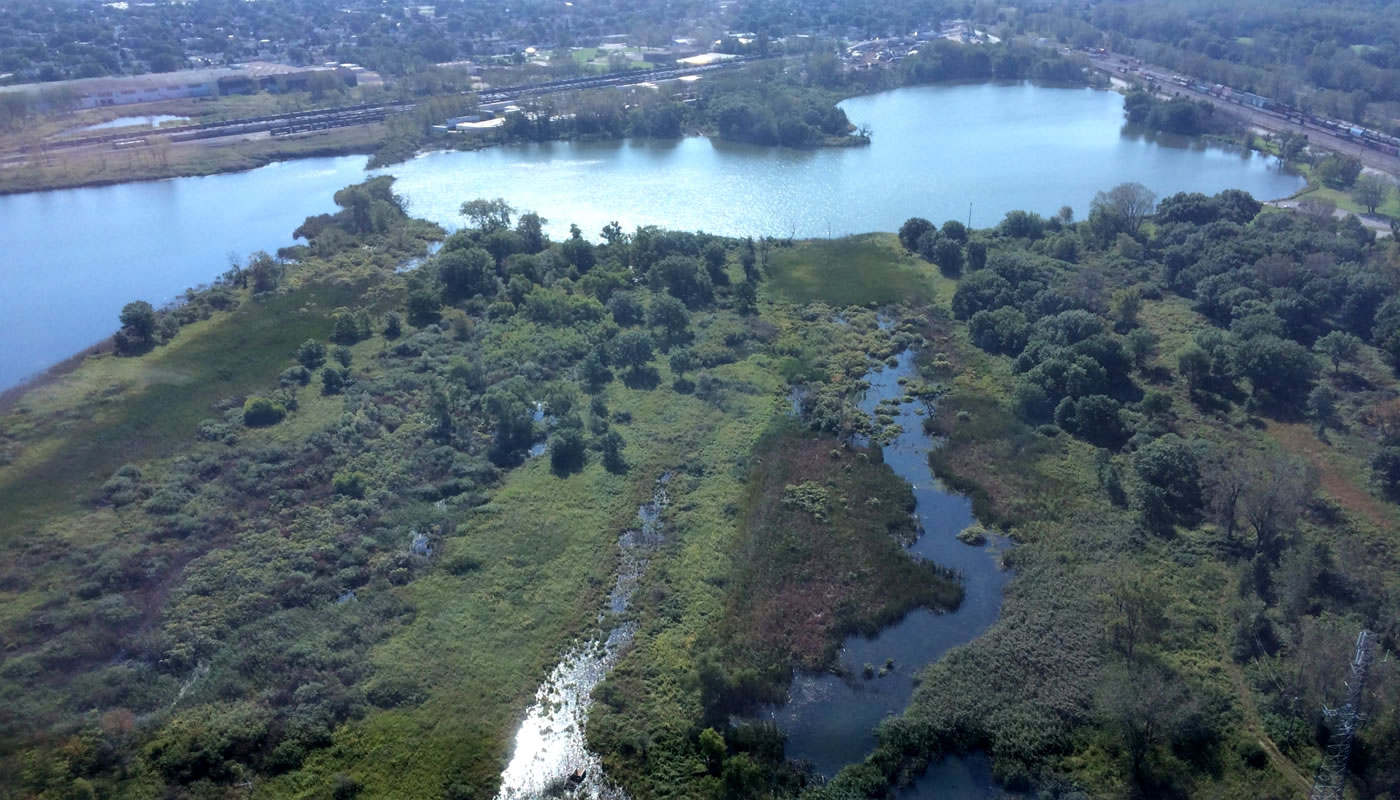A three-year restoration project at Powderhorn Lake forest preserve has restored more than 100 acres of wetlands. This project was made possible through a partnership between the National Oceanic and Atmospheric Administration, Great Lakes Commission, Illinois Department of Natural Resources, Audubon Great Lakes and Forest Preserves of Cook County. Ongoing restoration and maintenance efforts are currently in place to ensure long-term health and vitality of the wetlands.
On this page:
Project Completed October 2023
Learn more about the results of the Powderhorn Lake Habitat Restoration from our partner, Audubon Great Lakes.
Background
Located on the far southeast side of Chicago, the Powderhorn Lake forest preserve features both the 50-acre Powderhorn Lake as well as the Powderhorn Prairie and Marsh Nature Preserve. The preserve supports sand savanna, prairie and wetland habitats and many rare species, like eastern prickly pear, marsh speedwell and rockrose.
Powderhorn’s landscape provides an excellent example of the dune and swale topography— parallel sandy ridges alternating with low wetlands—that was once common in the Calumet Region but now is considered globally rare.
Like locations across the Calumet Region, a century of urban and industrial development has fundamentally altered the natural conditions and processes at Powderhorn. For more than a decade, the hydrological conditions at this site have supported unnaturally high water levels in Powderhorn Lake. When the lake fills, water historically flowed into the swales of the nature preserve, increasing invasion by weeds and destroying native plants and animal habitats.
Prior to the restoration efforts, the northern end of the lake was no longer shallow enough to provide an effective fish nursery, impacting the stock of species like northern pike, largemouth bass, yellow perch and American grass pickerel. Under these conditions, the boat launch platform was very close to the water line, making it difficult for boaters and paddlers to access the lake.
Restoration Work
This three-year restoration project has restored more than 100 acres of wetlands by reconnecting the northern marsh of Powderhorn Lake, which was once a shallow wetland, to Wolf Lake. Using a water control structure at the north end of Powderhorn Lake, land managers are now able to lower or maintain the water level as needed to recreate historic conditions, allowing water to drain safely from Powderhorn Lake through the northern marsh and into Wolf Lake and the Calumet River.
This connection has reduced water levels at Powderhorn Lake, helping to reestablish the vital marsh habitat needed to support birds like least bittern, common gallinule and pied-billed grebe. The northern shallows now ac as an effective fish nursery and the connection to Wolf Lake allows fish to move between lakes, bolstering populations of game and non-game fish like northern pike, largemouth bass, lake chubsucker and the state-threatened banded killifish. Adjacent neighborhoods will also experience a reduction in flooding.
The completed project has yielded numerous successes and significant benefits. It has created a half-mile-long system of underground pipes, deepened water channels and a new creek that reinstated crucial hydrological connections between Powderhorn Lake and Wolf Lake which ultimately connects to Lake Michigan. The system has been engineered to prioritize safe passage that serves a diverse aquatic ecosystem, including fish, turtles and wetland birds.
Furthermore, this restoration project stands as a testament to the collaborative efforts of multiple agencies working together to achieve a unique and ambitious goal. Its significance extends beyond improving water quality and wildlife habitats. It repurposed urban space, mitigated local flooding issues, provided new habitats for a variety of species, established a green corridor for wildlife movement and ultimately reconnected Powderhorn Lake to Lake Michigan. In essence, this project exemplifies cooperative environmental stewardship with profound and far-reaching positive impacts for both the community as well as native plants and animals.
This work was supported by Audubon Great Lakes through a $973,688 grant from the Great Lakes Commission and National Oceanic and Atmospheric Administration with Great Lakes Restoration Initiative funding.
Work History
Summer 2021: Engineers and designers finished the planning phase.
Winter 2022: Construction began.
Fall 2023: The project reached its conclusion.
Spring/Summer 2024: Additional monitoring efforts in cooperation with the Illinois Natural History Survey will take place.
More Information
- Fact Sheet – Great Lakes Commission (PDF)
- Habitat Restoration in Priority Coastal Areas: Powderhorn Lake – Great Lakes Commission
- More Than 100 Acres of Wetlands to be Restored on Southeast Side of Chicago – Audubon Great Lakes
- Powderhorn Lake Habitat Restoration – Audubon Great Lakes

